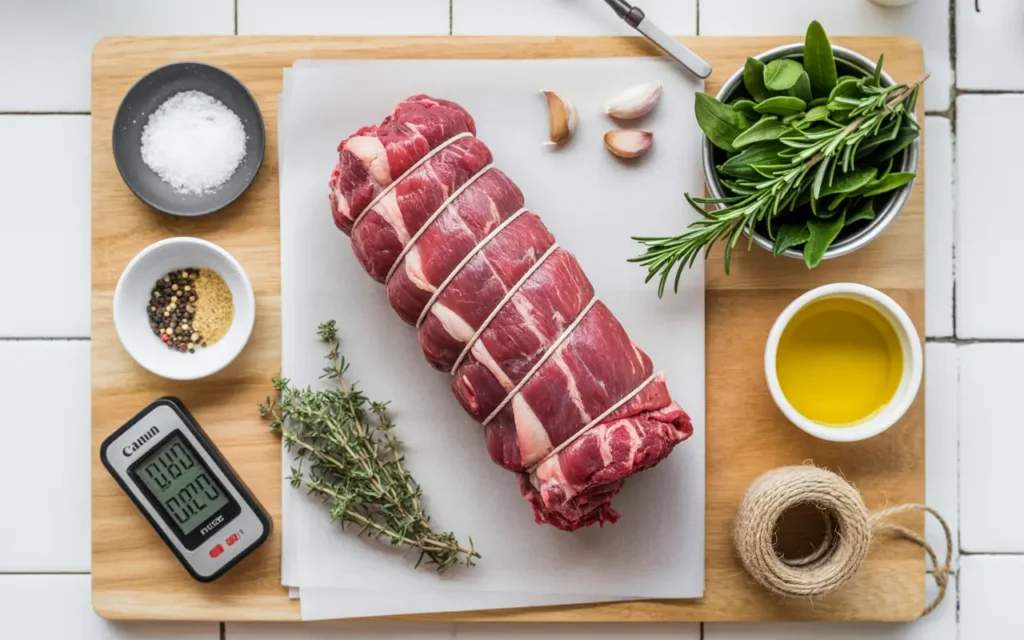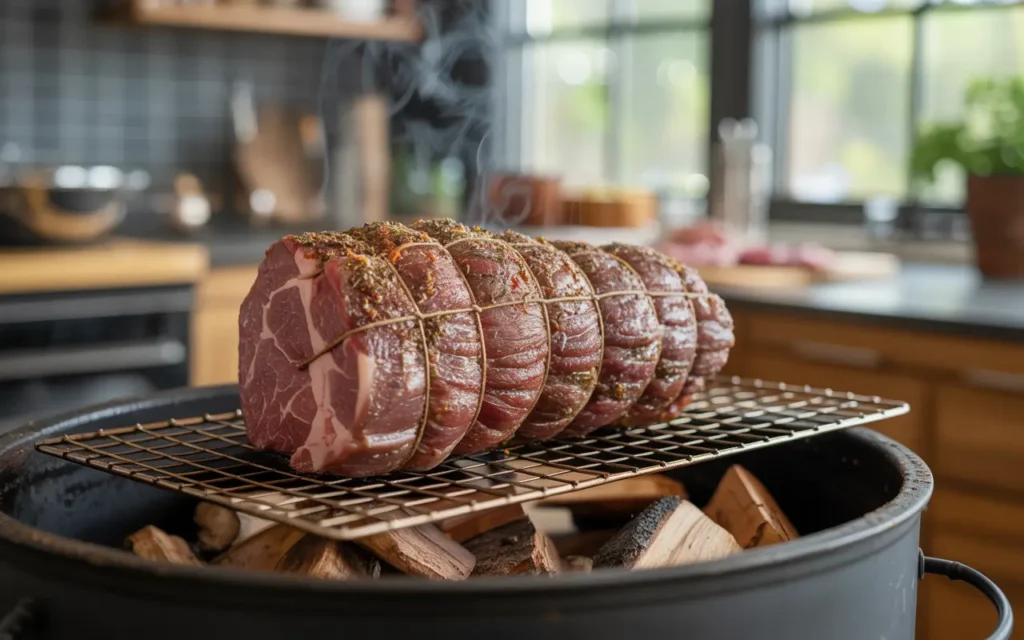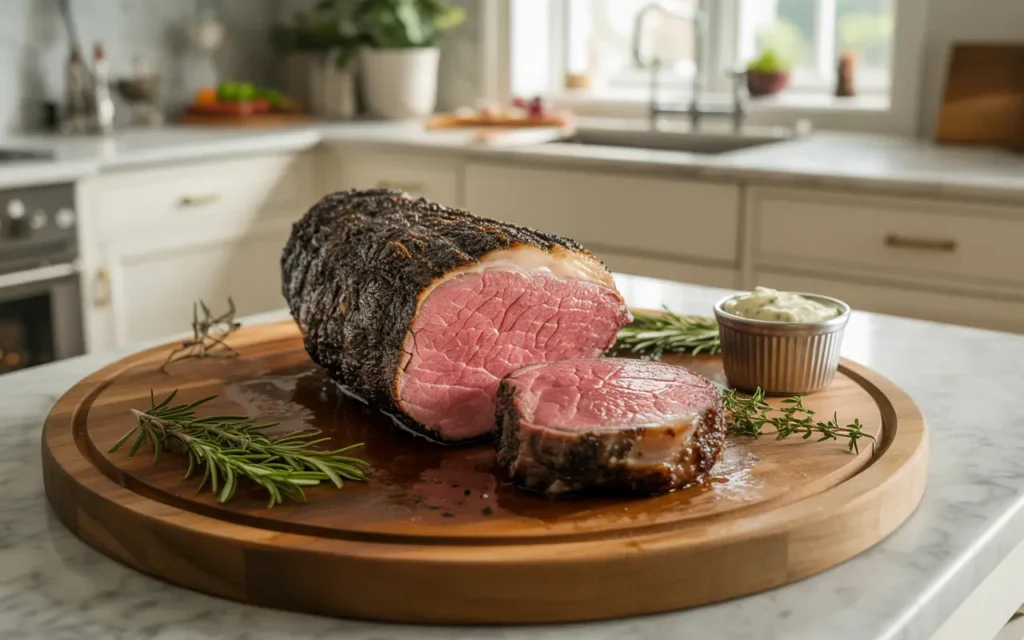Introduction
The first time I prepared smoked beef tenderloin was for my husband’s 40th birthday. I was terrified, to be honest. This premium cut of meat isn’t exactly budget-friendly, and the thought of ruining it kept me up the night before. But when I saw the look on everyone’s faces as I brought that perfectly pink, smoke-infused masterpiece to the table, I knew this recipe would become part of our family’s celebration tradition.
Have you ever wanted to create a restaurant-quality main dish that makes your guests think you’ve been secretly training as a professional chef? This smoked beef tenderloin recipe is exactly that kind of showstopper. Trust me, I’ve experimented with countless smoked beef recipes over the years, but this one stands in a class all its own.
Let me tell you a secret – I tried this recipe five times before perfecting the technique. The key was finding that sweet spot between smoke exposure and temperature control. Now that I’ve mastered it, I’m thrilled to share it with you, my kitchen confidants!
Table of Contents
Ingredients List

For the Beef Tenderloin:
- 1 whole beef tenderloin (4-5 pounds), trimmed and silver skin removed
- 3 tablespoons olive oil (I use the extra virgin olive oil I discovered at a small farm stand in California last summer)
- 4 garlic cloves, minced (Fresh garlic makes all the difference – I grow my own in small pots on my kitchen windowsill)
- 2 tablespoons fresh rosemary, finely chopped
- 2 tablespoons fresh thyme leaves
- 1 tablespoon coarse kosher salt (The flaky Jacobsen sea salt from Oregon is my current obsession)
- 2 teaspoons freshly ground black pepper
- 1 teaspoon paprika
- ½ teaspoon onion powder
For the Herb Butter (Optional but Recommended):
- ½ cup unsalted butter, softened to room temperature
- 2 tablespoons fresh parsley, finely chopped
- 1 tablespoon fresh chives, minced
- 1 garlic clove, very finely minced
- ½ teaspoon lemon zest
- ¼ teaspoon salt
- ¼ teaspoon black pepper
When you open that package of fresh herbs, you’ll immediately notice their vibrant, aromatic fragrance – that’s how you know they’ll infuse your tenderloin with incredible flavor. If you can’t find fresh herbs, dried will work in a pinch (use about 1/3 the amount), but the complex aromas of fresh herbs really make this recipe special.
Timing
Preparation Time: 30 minutes
Marinating Time: 2 hours minimum, overnight preferred
Smoking Time: Approximately 1.5-2 hours
Resting Time: 15-20 minutes
Total Time: About 4 hours (not including overnight marination)
I usually prep this recipe the day before we’re hosting a special dinner. My Sunday afternoon routine often involves trimming and seasoning the tenderloin while my kids are finishing their weekend homework at the kitchen table. This gives the meat plenty of time to absorb all those wonderful flavors overnight.
This smoked beef tenderloin has become my go-to recipe for milestone celebrations and holiday gatherings. Even though it takes some time, most of it is hands-off, which means I can focus on preparing sides or spending time with my guests while the smoker works its magic.
Step-by-Step Instructions

Step 1: Prepare the Beef Tenderloin
Start by trimming your beef tenderloin. Using a sharp knife, remove the silver skin (that tough, silvery membrane) and any excess fat. Don’t skip this step! The first time I made smoked beef tenderloin, I left too much silver skin on, and it created a chewy texture that detracted from the melt-in-your-mouth experience this cut should deliver.
Fold the thin “tail” end of the tenderloin underneath and secure with butcher’s twine. Then tie loops of twine around the tenderloin every 1-2 inches to create an even cylindrical shape. This ensures the meat cooks evenly throughout.
Step 2: Create the Rub
In a small bowl, combine the olive oil, minced garlic, chopped rosemary, thyme leaves, kosher salt, black pepper, paprika, and onion powder. Mix thoroughly to create a paste-like consistency.
The aroma of this herb and spice mixture is absolutely intoxicating! When my daughter walked into the kitchen the last time I made this, she immediately asked, “Is it Dad’s birthday again?” Just from the smell of the rub!
Step 3: Season the Meat
Using your hands (I always recommend wearing food-safe gloves), massage the herb mixture all over the beef tenderloin, ensuring every part is well-coated. The first time I made this, I was a bit shy with my seasoning application – don’t be! Really work it into all the surfaces.
Place the seasoned tenderloin on a baking sheet or in a container, cover with plastic wrap, and refrigerate for at least 2 hours. For maximum flavor infusion, I highly recommend marinating overnight. Trust me, this patience pays off tremendously in the final result.
Step 4: Prepare Your Smoker
Preheat your smoker to 225°F (107°C). For smoke flavor, I find that oak, hickory, or cherry wood pairs beautifully with beef tenderloin. My personal favorite is a mix of oak for a strong base flavor with a bit of cherry wood to add a subtle sweetness.
Make sure your wood chips or chunks are soaked if needed (follow your smoker’s specific instructions). I’ve learned through many smoking sessions that consistent temperature is absolutely crucial for perfect results.
Step 5: Smoke the Tenderloin
Remove the tenderloin from the refrigerator about 30-45 minutes before smoking to allow it to come closer to room temperature. This promotes more even cooking – a trick I learned after my first attempt resulted in a too-rare center and overcooked exterior.
Place the tenderloin directly on the smoker grates and insert a reliable meat thermometer into the thickest part. Close the lid and let the magic happen!
Smoke the tenderloin until it reaches an internal temperature of 125°F (52°C) for rare, 135°F (57°C) for medium-rare, or 145°F (63°C) for medium. This typically takes 1.5-2 hours, but always cook to temperature, not time. My family prefers medium-rare, so I aim for that 135°F sweet spot.
Step 6: Prepare the Herb Butter (While Smoking)
While your beef is smoking, prepare the herb butter if using. In a small bowl, combine the softened butter, parsley, chives, minced garlic, lemon zest, salt, and pepper. Mix until well combined.
Transfer the mixture onto a piece of plastic wrap, shape into a log, wrap tightly, and refrigerate until ready to use. The herb butter can be made up to three days in advance – I often prepare it while the beef is marinating the day before.
Step 7: Rest and Serve
This is critical! When the tenderloin reaches your desired internal temperature, remove it from the smoker and place it on a cutting board. Loosely tent with aluminum foil and let it rest for 15-20 minutes.
The first time I skipped adequate resting time (I was too excited to serve it!), all those magnificent juices ran out onto the cutting board instead of redistributing throughout the meat. Learn from my mistake – the rest is non-negotiable for maximum juiciness!
While the meat is resting, take the herb butter out of the refrigerator to soften slightly.
After resting, remove the butcher’s twine. Slice the tenderloin into ½-inch medallions and place them on a warmed serving platter. Top each medallion with a small pat of the herb butter, which will melt beautifully over the hot meat.
Nutritional Information
Understanding what’s in your food is important, even for special occasion dishes. Here’s the approximate nutritional breakdown per 4-ounce serving of smoked beef tenderloin (without herb butter):
- Calories: 250
- Protein: 28g
- Fat: 15g (5g saturated)
- Carbohydrates: 1g
- Sodium: 440mg
- Potassium: 320mg
- Iron: 15% DV
As someone who tries to balance indulgence with nutrition, I appreciate that beef tenderloin is relatively lean compared to other beef cuts, while still delivering that satisfying richness we crave for special occasions. The protein content is excellent, making this a satiating main dish that won’t leave you hungry an hour later!
Healthier Alternatives for the Recipe
While beef tenderloin is already one of the leaner cuts of beef, there are several ways to make this recipe fit various dietary needs:
Lower Sodium Version: Reduce the salt in the rub by half and use herbs to amplify flavors. When my dad was put on a low-sodium diet last year, I created this modification that still delivered amazing taste without compromising his health needs.
Lighter Option: Skip the herb butter and instead finish with a squeeze of fresh lemon juice and extra fresh herbs just before serving. The acidity brightens the flavor profile while cutting down on additional fat.
For a Different Protein: If red meat isn’t your thing, this same technique and seasoning blend works wonderfully with pork tenderloin, though the smoking time will be shorter. My sister-in-law doesn’t eat beef, and she raved about the smoked pork version I created for her birthday dinner.
Spice Modifications: If you’re sensitive to garlic or onion, replace these with 1 tablespoon of finely chopped shallots or a teaspoon of celery seed for a different but complementary flavor profile.
Serving Suggestions

Smoked beef tenderloin deserves elegant accompaniments that complement its rich flavor without overshadowing it. Here are my favorite pairings:
Side Dishes:
- Roasted garlic mashed potatoes (the creamy texture is divine alongside the tender beef)
- Grilled asparagus with lemon zest (the brightness cuts through the richness)
- Wild mushroom risotto (my husband’s absolute favorite pairing)
- Roasted root vegetables with thyme (perfect for fall and winter gatherings)
- Simple arugula salad with aged balsamic vinaigrette (the peppery greens and sweet-tart dressing are perfect foils)
Sauce Options:
- Creamy horseradish sauce (my father-in-law’s must-have accompaniment)
- Caramelized onion and mushroom compote
- Classic béarnaise sauce for ultra-special occasions
I served this tenderloin with rosemary roasted fingerling potatoes and haricots verts for my daughter’s high school graduation celebration, and guests were taking photos of their plates before digging in! For my parents’ 45th anniversary, I paired it with a wild mushroom ragout that complemented the smokiness perfectly.
This dish truly shines as the centerpiece of holiday meals, milestone birthdays, or anniversary celebrations. It has that “wow factor” that makes any gathering feel like a special occasion.
Common Mistakes to Avoid
Over my years of perfecting smoked beef recipes, I’ve made plenty of mistakes so you don’t have to! Here are the pitfalls to avoid:
Skipping the Trimming: Taking the time to properly remove the silver skin is essential. During my first attempt, I rushed this step, and some dinner guests were discretely removing tough bits from their mouths – how embarrassing!
Inconsistent Smoker Temperature: Fluctuating temperatures lead to uneven cooking. I once got distracted by a phone call and returned to find my smoker had dipped to 180°F. The result? An extra hour of cooking time and slightly dried-out edges.
Opening the Smoker Too Often: I know it’s tempting to peek (I’m guilty of this myself!), but every time you open the smoker, you lose heat and extend cooking time. Trust your thermometer!
Undercooking or Overcooking: Invest in a reliable meat thermometer. That $30 digital thermometer saved me from many expensive cooking disasters. Remember that carryover cooking will raise the temperature another 5-10 degrees during resting.
Cutting Into the Meat Too Soon: I’ve learned this lesson the hard way – slicing too early lets all those flavorful juices escape. The first time I made this recipe, my impatience resulted in a cutting board swimming in juices that should have remained in the meat!
Using Low-Quality Meat: For a recipe this simple, quality truly matters. When I switched from supermarket beef to tenderloin from a local butcher, the difference was night and day. If possible, choose grass-fed or prime-grade beef for the best results.
Storing Tips for the Recipe
Properly stored, your smoked beef tenderloin can continue to delight for several days:
Refrigeration: Cool the tenderloin completely before storing. Slice only what you need, leaving the remainder whole if possible – this helps retain moisture. Store in an airtight container in the refrigerator for up to 4 days. I usually place a slightly damp paper towel in the container to help maintain humidity.
Reheating: This is crucial! Low and slow is the way to go. When I’m in a hurry, I’m tempted to microwave leftovers, but that leads to tough, overcooked meat. Instead, I wrap tenderloin slices in foil with a tablespoon of beef broth or water and heat in a 275°F oven just until warmed through (about 10-15 minutes).
Freezing: While fresh is best, you can freeze leftover tenderloin for up to 2 months. Wrap individual portions tightly in plastic wrap, then foil, before placing in freezer bags. Thaw overnight in the refrigerator before gently reheating.
Meal Prep Ideas: I often intentionally smoke a larger tenderloin than needed because the leftovers are incredible. Thinly sliced cold tenderloin makes luxurious sandwiches with horseradish cream, arugula, and thin-sliced red onion. My family also loves it diced in morning breakfast hash with sweet potatoes and a sunny-side-up egg on top.
FAQs
“Bella, can I smoke a frozen beef tenderloin, or does it need to be thawed?”
Great question, Sarah from Boston! Always thaw your tenderloin completely before smoking. A frozen or partially frozen tenderloin will cook unevenly and won’t properly absorb the smoke flavor. I recommend thawing in the refrigerator for 24-48 hours, depending on size.
“How do I know which wood chips work best for beef tenderloin?”
James from Texas recently asked me this! For beef tenderloin, I recommend moderately strong woods like oak or hickory, perhaps mixed with a fruity wood like cherry or apple for complexity. Avoid very strong woods like mesquite which can overpower the delicate flavor of tenderloin. My personal favorite combination is 70% oak and 30% cherry.
“Can I make this recipe without a smoker?”
Absolutely, Maria from Chicago! While you won’t get the same smoke infusion, you can achieve a delicious result by searing the tenderloin in a cast-iron skillet, then finishing it in a 275°F oven until it reaches your desired internal temperature. Add a drop of liquid smoke to your rub for a hint of smokiness.
“My tenderloin always comes out too rare in the center and too done on the ends. Help!”
I struggled with this too, Rebecca! Two tricks solved this problem for me: First, ensure your tenderloin is an even thickness by tucking the tapered end underneath and tying with twine. Second, let the meat come to room temperature for 30-45 minutes before smoking. This creates a more even temperature gradient from outside to center.
“How much tenderloin should I prepare per person?”
For a main course, calculate about 6-8 ounces of raw tenderloin per adult. This accounts for some shrinkage during cooking. When I’m hosting my brother’s family with their teenage boys, I definitely lean toward the higher estimate – growing kids can really put away some protein!
Conclusion
Smoked beef tenderloin transforms any meal into a memorable occasion. With its perfect balance of smoky exterior and juicy, tender interior, this recipe showcases beef at its finest. The patience required – from proper trimming to low-and-slow smoking to that essential resting period – results in a centerpiece dish worthy of your most significant celebrations.
I’m eager to hear about your experiences with this recipe! Share your photos with me or leave a comment below. Did you try a different wood combination? Pair it with a side dish I haven’t mentioned? I love seeing how you make these recipes your own in your kitchen.
If you enjoyed this smoked beef recipe, be sure to subscribe to my newsletter for more seasonal specialties and cooking tips. And remember, the most important ingredient in any special occasion dish is the love you put into preparing it for the people who gather around your table.
Happy smoking!
– Bella

